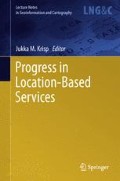Abstract
Hierarchical place descriptions are a common means for people to communicate about place. Within them hierarchically ordered elements are linked by explicit or implicit relationships. This study analyses place descriptions collected in a mobile game, investigating hierarchies based on a classification of spatial granularity. The main findings show a dominance of hierarchical structures in place descriptions, but also a considerable number of deviations. Deviations are explained by principles other than spatial granularity, such as the presence of salient features and other construction principles. We conclude the need for and significance of more flexible models of hierarchies in the interaction with users of location-based services.
Access this chapter
Tax calculation will be finalised at checkout
Purchases are for personal use only
Notes
- 1.
Salience refers to outstanding perceptual or semantic properties of a feature, while prominence refers to the degree of shared knowledge about a feature in a community. While the two terms are not synonymous it can be expected that salient features over time also become prominent. In this chapter no strict distinction is needed; mostly, the term salience will be used. For example, the Eiffel Tower is a salient feature because of its unique pyramid-shaped, metal skeleton construction that is very different from the rest of the buildings in Paris. However, it has also become one of France’s most prominent (or well-known) features, and certainly a feature that is associated with Paris. Therefore, it can be used as an anchor point of place descriptions in the city of Paris. However, it has also become one of France’s most prominent (or well-known) features, and certainly a feature that is associated with Paris. Therefore, it can be used as an anchor-point of place descriptions in the city of Paris.
- 2.
- 3.
http://gate.ac.uk, implemented in Java
References
Couclelis H, Golledge RG, Gale N, Tobler W (1987) Exploring the anchor-point hypothesis of spatial cognition. J Environ Psychol 7(2):99–122
Cunningham H (2002) Gate, a general architecture for text engineering. Comput Humanit 36(2):223
Dale R, Geldof S, Prost J-P (2005) Using natural language generation in automatic route description. J Res Practice Inf Technol 37(1):89–105
Grice HP (1975) Logic and conversation. In: Cole P, Morgan JL (eds) Speech acts, vol 2. Academic, New York, pp 41–58
Hansen S, Richter K-F, Klippel A (2006) Landmarks in openls: a data structure for cognitive ergonomic route directions. In: Raubal M, Miller HJ, Frank AU, Goodchild MF (eds) Geographic information science, vol 4197. Springer, Heidelberg, pp 128–144
Hirtle SC, Jonides J (1985) Evidence of hierarchies in cognitive maps. Memory and cognition 13(3):208–217
Ishikawa T, Montello DR (2006) Spatial knowledge acquisition from direct experience in the environment: individual differences in the development of metric knowledge and the integration of separately learned places. Cogn Psychol 52(2):93–129
Kelleher J, Kruijff G-JM (2006) Incremental generation of spatial referring expressions in situated dialog. In: 21st international conference on computational linguistics, Association for computational linguistics. Sydney, Australia
Montello D (1993) Scale and multiple psychologies of space. In: Frank A, Campari I (eds) Spatial information theory a theoretical basis for gis, vol 716. Springer, Heidelberg, pp 312–321
Plumert JM, Spalding TL, Nichols-Whitehead P (2001) Preferences for ascending and descending hierarchical organization in spatial communication. Mem Cogn 29(2):274–284
Raubal M, Winter S (2002) Enriching wayfinding instructions with local landmarks. In: Egenhofer M, Mark D (eds) Geographic information science, vol 2478. Springer, Heidelberg, pp 243–259
Richter K-F, Winter S (2011) Hierarchical representation of indoor spaces. Environ Plann B 38(6):1052–1070
Sadalla EK, Burroughs WJ, Staplin LJ (1980) Reference points in spatial cognition. J Exp Psychol: Hum Learn Mem 6(5):516–528
Schegloff EA (1972) Notes on a conversational practice: formulating place. In: Sudnow D (ed) Studies in social interaction, Vol 75. MacMillan, New York, pp 75–119
Shanon B (1979) Where questions. In: 17th annual meeting of the association for computational linguistics, University of California at San Diego, La Jolla, CA, ACL
Siegel AW, White SH (1975) The development of spatial representations of large-scale environments. In: Reese HW (ed) Advances in child development and behaviour, vol 10. Academic, New York, pp 9–55
Sorrows ME, Hirtle SC (1999) The Nature of landmarks for real and electronic spaces. In: Freksa C, Mark DM (eds) Spatial information theory, vol 1661. Springer, Heidelberg, pp 37–50
Stevens A, Coupe P (1978) Distortions in judged spatial relations. Cogn Psychol 10(4):422–437
Talmy L (1983) How language structures space. In: Pick H, Acredolo L (eds) Spatial orientation: theory, research, and application. Plenum Press, New York, pp 225–282
Taylor HA, Tversky B (1992) Descriptions and depictions of environments. Mem Cogn 20(5):483–496
Tenbrink T, Winter S (2009) Variable granularity in route directions. Spat Cogn Comput 9(1):64–93
Timpf S, Volta GS, Pollock DW, Frank AU, Egenhofer MJ (1992) A conceptual model of wayfinding using multiple levels of abstraction. In: Frank AU, Campari I, Formentini U (eds) Theories and methods of spatio-temporal reasoning in geographic space, vol 639. Springer, Berlin, pp 348–367
Tomko M, Winter S (2009) Pragmatic construction of destination descriptions for urban environments. Spat Cogn Comput 9(1):1–29
Tomko M, Winter S, Claramunt C (2008) Experiential hierarchies of streets. Comput Environ Urban Syst 32(1):41–52
Winter S, Richter KF, Baldwin T, Cavedon L, Stirling L, Duckham M, Kealy A, Rajabifard A (2011) Location-based mobile games for spatial knowledge acquisition. In: cognitive engineering for mobile GIS. Belfast ME. Workshop at COSIT 2011
Acknowledgments
The authors acknowledge support by the Australian Research Council (LP100200199), and wish to thank anonymous reviewers for comments that helped to improve the chapter.
Author information
Authors and Affiliations
Corresponding author
Editor information
Editors and Affiliations
Rights and permissions
Copyright information
© 2013 Springer-Verlag Berlin Heidelberg
About this chapter
Cite this chapter
Richter, D., Vasardani, M., Stirlng, L., Richter, KF., Winter, S. (2013). Zooming In–Zooming Out Hierarchies in Place Descriptions. In: Krisp, J. (eds) Progress in Location-Based Services. Lecture Notes in Geoinformation and Cartography. Springer, Berlin, Heidelberg. https://doi.org/10.1007/978-3-642-34203-5_19
Download citation
DOI: https://doi.org/10.1007/978-3-642-34203-5_19
Published:
Publisher Name: Springer, Berlin, Heidelberg
Print ISBN: 978-3-642-34202-8
Online ISBN: 978-3-642-34203-5
eBook Packages: Earth and Environmental ScienceEarth and Environmental Science (R0)

